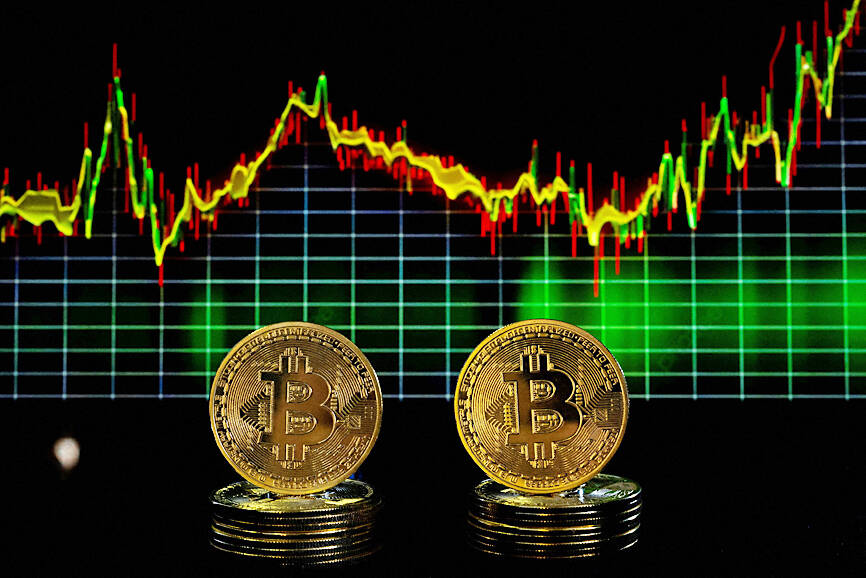Bitcoin breached US$120,000 for the first time, with investor enthusiasm showing few signs of dimming as the US House of Representatives prepares to consider key industry legislation during its “Crypto Week,” which was to start yesterday.
The cryptocurrency bellwether rose as much 3.4 percent to US$123,205 as of 9:10am in London as digital assets staged a broad advance. Ether, the second-largest token, also gained, along with a host of smaller coins.
After surging on the election of US President Donald Trump to a second term, bitcoin had settled into a pattern of fluctuating on either side of US$100,000 for several months. Concern about Trump’s political and economic policies had helped to temper optimism over the pro-crypto agenda of his administration. Now with other risk assets such as US stocks back around record highs, bitcoin has also resumed its push higher.

Photo: Reuters
Progress on crucial crypto legislation is adding fresh fuel to the rally. The US House this week is to debate and possibly vote on the Digital Asset Market Clarity Act, Anti-Central Bank Digital Currency Surveillance State Act and the US Senate’s Guiding and Establishing National Innovation for US Act, as Republicans move to advance Trump’s crypto-friendly agenda.
The prospect of a clear US regulatory framework, along with bitcoin’s steady advance in the face of Trump’s chaotic trade policy, has bolstered confidence in the asset class among institutional investors.
“This shift signals a maturing perspective on bitcoin — not merely a speculative asset, but a macro hedge and a structurally scarce store of value,” XBTO Trading LLC senior trader George Mandres said.
Bitcoin rose 31 percent for the year after more than doubling last year. Its renewed momentum has also spilled over to smaller tokens — second-ranked ether rose as much as 2.4 percent, while XRP and Solana were among other coins advancing yesterday.
“Bitcoin’s cleared US$120,000, but the real test is US$125,000,” BTC Markets analyst Rachael Lucas said.
While short-term profit booking can be expected, “the uptrend has fuel,” driven by strong demand from exchange-traded funds, she added.
“Support at US$112,000 and any dip looks like a buying opportunity, not a reversal,” she said.
Helping to fuel the latest rally was the liquidation of bearish crypto bets at the end of the week. Traders who shorted bitcoin bore the brunt of the rapid damage, with more than US$1 billion in positions wiped out, Coinglass data showed.
Some analysts are not totally sold on the token’s continued rise.
“In my view, this isn’t a macro-driven rally, but rather an isolated event,” Nansen Pte Ltd analyst Nicolai Sondergaard said. “That said, recent US policy developments such as fiscal expansion and expectations of further monetary easing have created a backdrop that is undeniably favorable for bitcoin.”

Taiwan Semiconductor Manufacturing Co (TSMC, 台積電) last week recorded an increase in the number of shareholders to the highest in almost eight months, despite its share price falling 3.38 percent from the previous week, Taiwan Stock Exchange data released on Saturday showed. As of Friday, TSMC had 1.88 million shareholders, the most since the week of April 25 and an increase of 31,870 from the previous week, the data showed. The number of shareholders jumped despite a drop of NT$50 (US$1.59), or 3.38 percent, in TSMC’s share price from a week earlier to NT$1,430, as investors took profits from their earlier gains

In a high-security Shenzhen laboratory, Chinese scientists have built what Washington has spent years trying to prevent: a prototype of a machine capable of producing the cutting-edge semiconductor chips that power artificial intelligence (AI), smartphones and weapons central to Western military dominance, Reuters has learned. Completed early this year and undergoing testing, the prototype fills nearly an entire factory floor. It was built by a team of former engineers from Dutch semiconductor giant ASML who reverse-engineered the company’s extreme ultraviolet lithography (EUV) machines, according to two people with knowledge of the project. EUV machines sit at the heart of a technological Cold

Taiwan’s long-term economic competitiveness will hinge not only on national champions like Taiwan Semiconductor Manufacturing Co. (TSMC, 台積電) but also on the widespread adoption of artificial intelligence (AI) and other emerging technologies, a US-based scholar has said. At a lecture in Taipei on Tuesday, Jeffrey Ding, assistant professor of political science at the George Washington University and author of "Technology and the Rise of Great Powers," argued that historical experience shows that general-purpose technologies (GPTs) — such as electricity, computers and now AI — shape long-term economic advantages through their diffusion across the broader economy. "What really matters is not who pioneers

TAIWAN VALUE CHAIN: Foxtron is to fully own Luxgen following the transaction and it plans to launch a new electric model, the Foxtron Bria, in Taiwan next year Yulon Motor Co (裕隆汽車) yesterday said that its board of directors approved the disposal of its electric vehicle (EV) unit, Luxgen Motor Co (納智捷汽車), to Foxtron Vehicle Technologies Co (鴻華先進) for NT$787.6 million (US$24.98 million). Foxtron, a half-half joint venture between Yulon affiliate Hua-Chuang Automobile Information Technical Center Co (華創車電) and Hon Hai Precision Industry Co (鴻海精密), expects to wrap up the deal in the first quarter of next year. Foxtron would fully own Luxgen following the transaction, including five car distributing companies, outlets and all employees. The deal is subject to the approval of the Fair Trade Commission, Foxtron said. “Foxtron will be